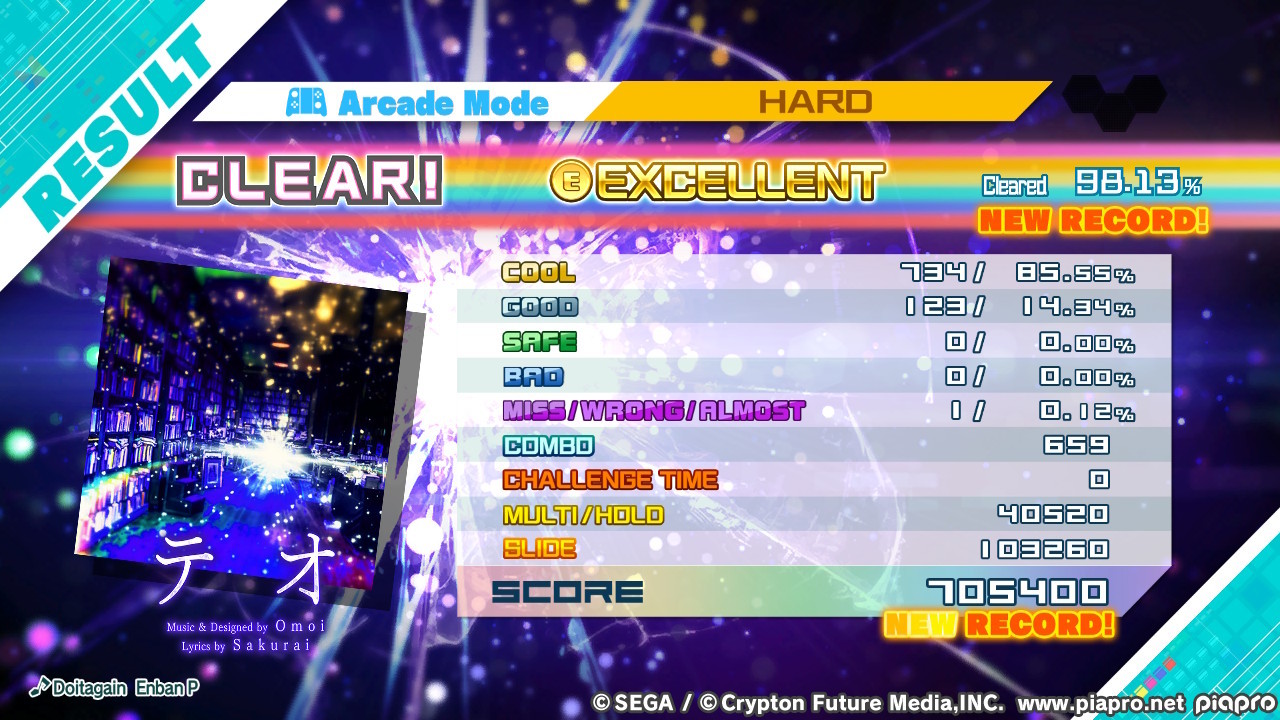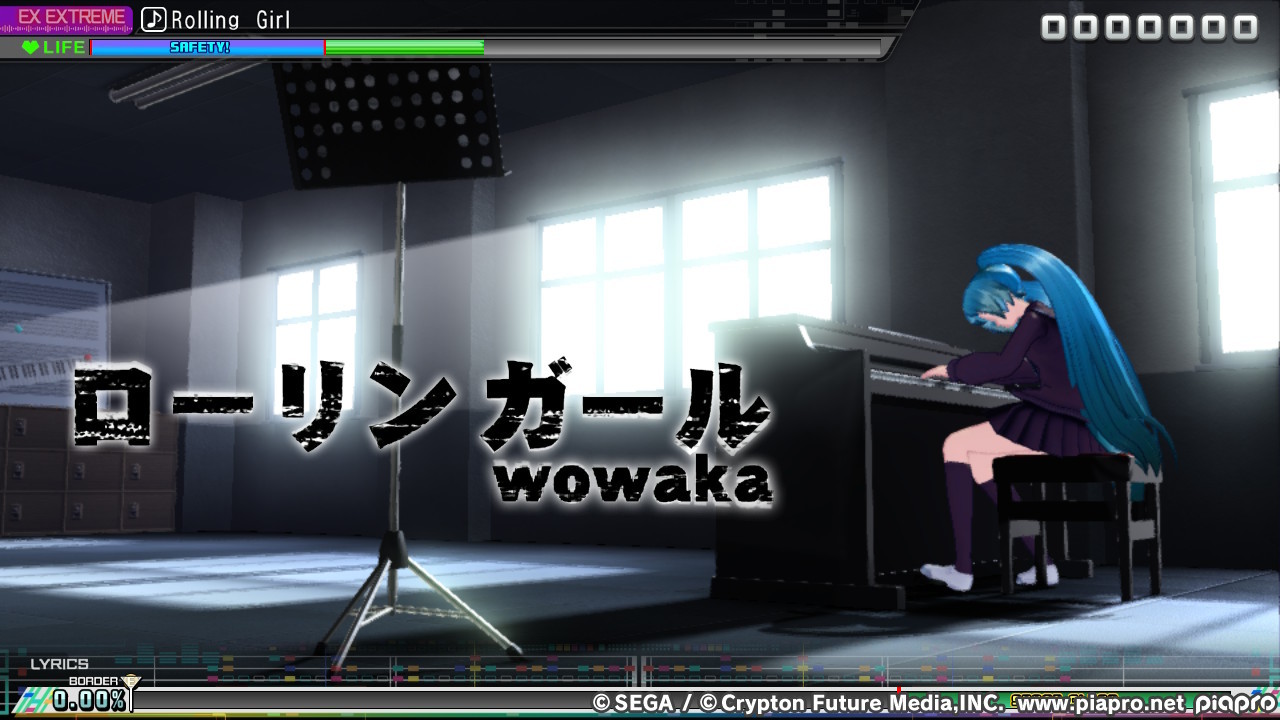The phenomenon around Vocaloid-based music and the anime-inspired mascots that personify these synthetic voices is one that brings tremendous joy to many. It's not just because our beloved blue-haired virtual pop idol has been the face for a subsection of Japanese music that we hold so dear--through the Project DIVA rhythm games, Miku has represented our way of personally connecting with hundreds of songs composed by a number of incredibly talented artists. With Hatsune Miku: Project DIVA MegaMix, we have yet another great collection of genre-defying tunes and all-new bangers that bring the series to Nintendo Switch in familiar, but terrific form.
MegaMix's rhythm gameplay system follows that of previous Project DIVA games; note patterns fly in from off-screen to form a continuous string of button prompts that sync to the beat of each song. When you choose to ramp up the difficulty, the face buttons or directional inputs (or any combination thereof) and shoulder button prompts begin to layer over one another at a rapid pace and challenge you to keep up. And it's a gratifying thrill when you've mastered your favorite songs, as if you're playing some role in the performance of the song itself, especially at Hard or Extreme difficulty when the button patterns begin to accentuate every intricate part of the instrumentation.
The Switch's portable nature makes it convenient to satisfy the impulse to crank out a few songs or get lost in hours of music, much like the desire to jam out for a while on an instrument you play. It's been quite some time since the PS Vita entries and the heavily modified 3DS versions, so the return to handheld form is a welcome one. Thankfully in MegaMix, you can swap out the Switch's letter-designated face button prompts to instead show up as either the appropriate directional arrows or as PlayStation's face button symbols (which is absolutely necessary since rapidly processing Nintendo's lettered-button prompts can throw you for a loop). Getting the timing right to rack up your score and the highest possible combo is nonetheless fulfilling as a long-time fan even though it very much shares the DNA of the ones I've poured hours into on Sony platforms. It's a tried-and-true foundation, but it's no less joyous here in MegaMix.
Of the 101 songs in the base game's library, you'll hear sugar-coated pop tunes, hard-hitting punk-infused tracks, frenetic J-rock jams, electronic bangers, and a few others that simply defy genre.
MegaMix features a brand-new playstyle called Mix Mode, which utilizes the JoyCon motion controls when detached. Instead of hitting buttons, you must align the JoyCon sensor with bars that flow downward on the screen and hit the corresponding trigger at the right time. It's a unique diversion from the regular Arcade Mode. However, it doesn't have much depth as the note patterns are limited, and the motion sensors can be too imprecise for the higher difficulty. Thus, the traditional style of play is where MegaMix shines.

Of the 101 songs in the base game's library, you'll hear sugar-coated pop tunes, hard-hitting punk-infused tracks, frenetic J-rock jams, electronic bangers, and a few others that simply defy genre. Classics from Miku and her counterparts Luka, Rin, Len, Meiko, and Kaito make up a bulk of the tracklist--favorites like "Senbonzakura" and "Akatsuki Arrival" still bump. The late artist Wowaka, who will always be remembered as an all-time great musician who used Vocaloid, has four of his previous songs here, including the infectious "World's End Dancehall" and the beloved "Rolling Girl." What makes MegaMix special in particular is the inclusion of 10 new tracks that make their debut in a Project DIVA game--and they are without a doubt top-tier songs.
"Catch The Wave" acts as MegaMix's theme song, and the playable version is an absolute delight with an adorable animated music video showing Miku and her fellow Vocaloid friends traveling the world. It hits you with uplifting electronic melodies and a resounding uptempo beat that'll boost your mood. Rin and Len are the stars in "Roki" which is a funky, fast-paced rock tune with both singers rapidly alternating and harmonizing with each other. When they yell at specific points in this song, their human-like rasp also serves as an example of how far the Vocaloid sound has come, further blurring the line between synthetic and natural. That feeling applies to another new song, "Teo," which features one of Miku's most expressive and emotional vocal tracks. While it blasts you with catchy distorted guitars and heavy synths in the minor key alongside robust percussions, Miku delivers the heartwrenching lyrics infectiously and convincingly.
I could easily go on and on explaining why my favorite new songs featured in Project DIVA MegaMix resonate so strongly, but it's all to say that you're bound to find incredible music regardless of your tastes. These new tracks are a microcosm of what makes Vocaloid-based music a beautiful thing and the Project DIVA rhythm games well-worth playing.

Every song is accompanied by background music videos either composed of stunning hand-drawn artwork or animated performances of 3D character models. Even as you're frantically trying to keep pace with note patterns, music videos deliver a spirited layer of charm to the entire experience. There's even an option to watch them on their own--if you don't understand Japanese or haven't looked up translated lyrics, you may still get a sense of the story behind a song just from the music video. They're like short-form anime episodes peeking into the life of Miku, Luka, or Rin, or what the composers themselves are trying to communicate.
The endearing hand-drawn slideshow in "Dreamin' Chuchu" is one of the cutest things in the entire game, and it's quite clear in showing a desperate young love as Luka makes chocolate treats as a gift. And Miku's adorable dance routine in "Alien Alien" is as silly as the animated backdrop and lyrics. While some songs and videos can be lighthearted fun, they're also important for conveying some of the heavier messages.
Vocaloid has given a voice to the voiceless, letting incredible multi-instrumentalists create songs with actual lyrics even if they themselves don't have the ability to sing.
The series of artwork and graphics in "Jigsaw Puzzle" and the dark, angry portrayal of Rin in "Tokyo Teddy Bear" express a sense of yearning and depression that's communicated in the songwriting. The quintessential punk-folk hybrid "Senbonzakura" touches on the troubles of reconciling cultural traditions tied to a dark history amid a changing world--it's reflected in the lyrics, video, and the instrumentation itself. And a Wowaka classic in "Two-Faced Lovers" throws motion graphics at you at a breakneck speed and ever so subtly unravels the dangers and complications of romance.

Now, there's a bit more to Project DIVA MegaMix than music, rhythm gameplay, and videos. As with previous entries, you earn points by completing songs depending on difficulty and performance. These points allow you to buy outfits, or "modules," letting you customize the hairstyles and clothing of the Vocaloid mascots for the 3D animated videos. A Switch-exclusive feature is the option to design your own t-shirt using the touchscreen, which you can wear in videos. Some modules are lacking in tastefulness, but a handful of them better suit a particular music video or straight up look cool--it's nice to mix up Miku's blue hair and blue tie ever so often and Luka's signature getup.
Given that MegaMix is more or less a port of Project DIVA Future Tone, the overall package is as expected: excellent music, solid rhythm gameplay, and module customization. Past games like Project DIVA X had a brief tour-themed campaign with additional customization, and the 3DS's Project Mirai DX even included a few minigames. So, all things considered, it's a little disappointing to see a lack of complementary features in MegaMix.
The only other shortcoming is that the presentation of note patterns can cause problems in a number of tracks on Extreme difficulty. The screen gets cluttered, obscuring the sequence and placement of the notes among each other, which makes the pattern unnecessarily tricky to decipher. It's a problem that lies outside of my skill to keep rhythm with increasingly complex patterns. Pouring time into practice mode and rewinding to retry tougher sections of songs will help, but this is a flaw in how Extreme note charts are displayed, which is inherent to the series.
Minor shortcomings aside, Project DIVA MegaMix is a wonderful representation of why so many of us cherish Vocaloid-based music and, by extension, these rhythm games starring Hatsune Miku and friends. Sure, there might be a silly aspect to personifying virtualized characters like pop idols, but the music behind it is very real. Vocaloid has given a voice to the voiceless, letting incredible multi-instrumentalists create songs with actual lyrics even if they themselves don't have the ability to sing. And those of us who don't have their level of talent can at least take part in playing some of their best songs through the Project DIVA rhythm game series, which now lives on Switch in excellent form.